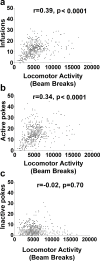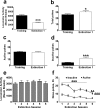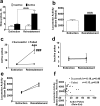Locomotor activity: A distinctive index in morphine self-administration in rats
- PMID: 28380023
- PMCID: PMC5381783
- DOI: 10.1371/journal.pone.0174272
Locomotor activity: A distinctive index in morphine self-administration in rats
Abstract
Self-administration of addictive drugs is a widely used tool for studying behavioral, neurobiological, and genetic factors in addiction. However, how locomotor activity is affected during self-administration of addictive drugs has not been extensively studied. In our present study, we tested the locomotor activity levels during acquisition, extinction and reinstatement of morphine self-administration in rats. We found that compared with saline self-administration (SA), rats that trained with morphine SA had higher locomotor activity. Rats that successfully acquired SA also showed higher locomotor activity than rats that failed in acquiring SA. Moreover, locomotor activity was correlated with the number of drug infusions but not with the number of inactive pokes. We also tested the locomotor activity in the extinction and the morphine-primed reinstatement session. Interestingly, we found that in the first extinction session, although the number of active pokes did not change, the locomotor activity was significantly lower than in the last acquisition session, and this decrease can be maintained for at least six days. Finally, morphine priming enhanced the locomotor activity during the reinstatement test, regardless of if the active pokes were significantly increased or not. Our results clearly suggest that locomotor activity, which may reflect the pharmacological effects of morphine, is different from drug seeking behavior and is a distinctive index in drug self-administration.
Conflict of interest statement
Figures





Similar articles
-
Locomotor activity and cocaine-seeking behavior during acquisition and reinstatement of operant self-administration behavior in rats.Behav Brain Res. 2005 May 28;160(2):250-9. doi: 10.1016/j.bbr.2004.12.005. Epub 2005 Jan 12. Behav Brain Res. 2005. PMID: 15863221
-
Inhibition of CaMKII activity in the nucleus accumbens shell blocks the reinstatement of morphine-seeking behavior in rats.Neurosci Lett. 2012 Jun 19;518(2):167-71. doi: 10.1016/j.neulet.2012.05.003. Epub 2012 May 8. Neurosci Lett. 2012. PMID: 22579819
-
Selegiline modifies the extinction of responding following morphine self-administration, but does not alter cue-induced reinstatement, reacquisition of morphine reinforcement, or precipitated withdrawal.Pharmacol Res. 2005 Jan;51(1):69-78. doi: 10.1016/j.phrs.2004.07.004. Pharmacol Res. 2005. PMID: 15519537
-
Delayed extinction and stronger drug-primed reinstatement of methamphetamine seeking in rats prenatally exposed to morphine.Neurobiol Learn Mem. 2016 Feb;128:56-64. doi: 10.1016/j.nlm.2015.12.002. Epub 2015 Dec 29. Neurobiol Learn Mem. 2016. PMID: 26743042
-
Locomotor activity does not predict individual differences in morphine self-administration in rats.Pharmacol Biochem Behav. 2018 Mar;166:48-56. doi: 10.1016/j.pbb.2018.01.008. Epub 2018 Feb 2. Pharmacol Biochem Behav. 2018. PMID: 29409807 Free PMC article.
Cited by
-
Exploring the Role of DARPP-32 in Addiction: A Review of the Current Limitations of Addiction Treatment Pathways and the Role of DARPP-32 to Improve Them.NeuroSci. 2022 Aug 25;3(3):494-509. doi: 10.3390/neurosci3030035. eCollection 2022 Sep. NeuroSci. 2022. PMID: 39483434 Free PMC article. Review.
-
Loss of SUR1 subtype KATP channels alters antinociception and locomotor activity after opioid administration.Behav Brain Res. 2021 Sep 24;414:113467. doi: 10.1016/j.bbr.2021.113467. Epub 2021 Jul 15. Behav Brain Res. 2021. PMID: 34274374 Free PMC article.
-
HIV-1 Tat Protein Promotes Neuroendocrine Dysfunction Concurrent with the Potentiation of Oxycodone's Psychomotor Effects in Female Mice.Viruses. 2021 Apr 30;13(5):813. doi: 10.3390/v13050813. Viruses. 2021. PMID: 33946474 Free PMC article.
-
Computer Methods for Automatic Locomotion and Gesture Tracking in Mice and Small Animals for Neuroscience Applications: A Survey.Sensors (Basel). 2019 Jul 25;19(15):3274. doi: 10.3390/s19153274. Sensors (Basel). 2019. PMID: 31349617 Free PMC article. Review.
-
Effects of novel beta-lactam, MC-100093, and ceftriaxone on astrocytic glutamate transporters and neuroinflammatory factors in nucleus accumbens of C57BL/6 mice exposed to escalated doses of morphine.Saudi Pharm J. 2024 Jul;32(7):102108. doi: 10.1016/j.jsps.2024.102108. Epub 2024 May 23. Saudi Pharm J. 2024. PMID: 38868175 Free PMC article.
References
-
- Weeks JR (1962) Experimental morphine addiction: method for automatic intravenous injections in unrestrained rats. Science 138: 143–144. - PubMed
-
- Gardner EL (2000) What we have learned about addiction from animal models of drug self-administration. Am J Addict 9: 285–313. - PubMed
-
- Roberts DC, Bennett SA (1993) Heroin self-administration in rats under a progressive ratio schedule of reinforcement. Psychopharmacology (Berl) 111: 215–218. - PubMed
-
- Griffiths RR, Findley JD, Brady JV, Dolan-Gutcher K, Robinson WW (1975) Comparison of progressive-ratio performance maintained by cocaine, methylphenidate and secobarbital. Psychopharmacologia 43: 81–83. - PubMed
-
- de Wit H, Stewart J (1981) Reinstatement of cocaine-reinforced responding in the rat. Psychopharmacology (Berl) 75: 134–143. - PubMed
MeSH terms
Substances
LinkOut - more resources
Full Text Sources
Other Literature Sources

